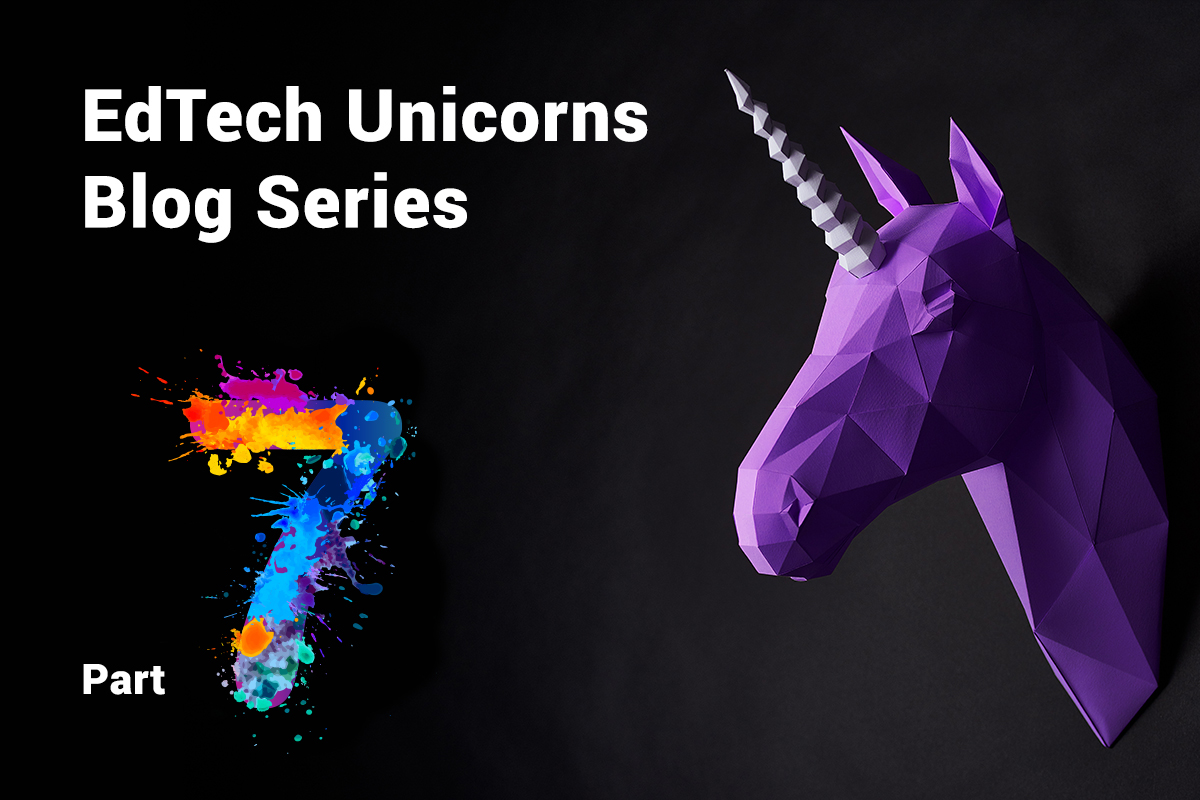In part 6 of our EdTech Unicorns Blog series, we introduced new unicorns that created the new LMS cluster. Since our last blog, four new unicorns have joined the EdTech Unicorn party: GoGuardian from the United States, upGrad and Emeritus from India, and most recently KidsLoop, the first EdTech Unicorn from South Korea.
While we are obsessed with Unicorns, we wanted to dedicate this blog to a special group of newcomers, and their unexplored territory, the noveau arriveés: the LMS cluster.
What industry is it? What is it about?
The introduction of the companies mentioned above confirms specific patterns that were slightly visible before; however, these newcomers shed light on the importance of these characteristics.
Learning Management Systems, or LMSs in short, include software that provides the framework that manages all aspects of a learning process; this solution allows one to host, organize, track, analyze and deliver learning content for learners within an organization. In other words, LMS are the virtual equivalent of a learning institution, from its classrooms, to teachers, however, without having to take long buses or simply deal with long waits for report cards.
Some LMSs specialize in specific industries, such as Yunxuetang (China), Degreed (United States), Go1 (Australia), and Articulate (United States) that target the corporate sector; or KidsLoop (South Korea) that specializes in early childhood and kindergarten education. Some companies, like Articulate and KidsLoop, will offer both an LMS and a Learning Content Management System (LCMS).
You might be asking “What do you mean LCMS? I thought this blog was only about LMSs.”
Even though companies in this cluster fall under the “LMS” umbrella, this group includes some other software that essentially serves a similar purpose as an LMS, but has some differences in their approach to managing learning experiences, hence their more specific names. Two trendy types of LMS are the previously mentioned LCMS and the emerging trends around a Learning Experience Platform (LXP).
- An LCMS is a software that is used to upload/create and manage learning content. An LMS can be complemented by an LCMS, but they are not the same as the LCMS does not offer many tools for reporting, analytics, and course creation.
- On the other hand, an LXP is more than just the next big Edtech fad, it is a social learning platform that curates a wide selection of content and learning paths based on the learner’s needs and personal learning preferences. If you want to learn more about LXPs, check out our blog, “What is a Learning Experience Platform”. We have provided a snapshot of their main differences below.
Learning Management Systems (LMS)
Yunxuetang, Degreed, Go1, Articulate offer software solutions that enable users to create, store, manage and deliver educational content for their learners. In short, they offer a Learning Management System (LMS). All these companies do not offer the same features on their platforms, but they all target the corporate learning sector.
LMS
- Content is designed for a specific group of people(a class or a group of new hirees).
- Content is highly structured.
- Content is grouped in courses or learning paths, which are usually not adjustable.
- Only managers and course creators can add content.
LXP
- ConDiverse content is personalized for each individual user by AI.
- User-generated and user-determined content and learning paths.
- Microlearning focus – flexibility on time availability and session length.
- Collaborative and social learning features – users can add materials to contribute to learning.
Why are they needed – What is the pain point they are trying to solve?
Every learning process, from a K-12 program for a school to a new employee onboarding program, needs a space to segment users, organize and deliver learning content while keeping records and creating reports on the learning process. Previously, this space was physical and concrete in nature and it relied on manual processes that slowed down the user, increased margin of error and provided limited improvement insights. In previous blogs in our series, we explored how in-person settings create limitations for the learning process, such as limiting the pools of learners to a geographic area or limiting the number of learners to venue capacity. More than that, as any classroom teacher can attest: delivering quality learning content becomes harder as the number of learners increases. Therefore, tracking and reporting each individual’s learning process was time-consuming as it relied on manual tasks. LMSs offer a digital space where organizations can host their learning processes in an effective and accessible way, automating and optimizing manual processes and using technology to improve learning experiences.
It is not hard to see why the demand for LMSs in education and corporate training increased. LMSs enabled organizations to do what manual processes couldn’t:
- Creating easier and more accessible learning by exploiting the benefits of technology and digitalization.
- Offering learners an opportunity to access a completely mobile house for all learning content.
- Leveraging Machine Learning/Artificial Intelligence (AI) to create personalized learning experiences, switching from the one-size-fits-all to a user-driven approach.
- Centralizing and optimizing learning processes by creating automatic reports on activities, learning progress, and learning improvements.
- Bringing consistency, reducing costs, and leveraging technology insights to create dynamic and effective learning experiences.
These companies became EdTech Unicorns because they offer effective and easy-to-use software solutions to manage learning processes. This is what we can learn from their software:
- Data is key. LMSs, more than just hosting learning processes, can create reports and offer key insights on performance, ROI, and learning achievements.
- Digital Learning must be a 360 experience to be compelling. To effectively convey learning programs, this software must be a complete solution covering all aspects of learning, from content creation, communication exercises to gamification to motivate learners.
- On-demand content completes the offering. Most of the Unicorns mentioned in this cluster offer their LMS software as their solution; however, what makes them Unicorns is that they also provide content available for their clients to use. As mentioned above, Kidsloop and Articulate through their LCMS even offer complete training/academic programs already made for clients to purchase and use in their LMS solutions.
- Artificial Intelligence makes learning even more accessible. These companies invest heavily in Artificial Intelligence to help companies create effortless experiences for their learners and offer insights to effectively implement their ideas using their software. Training processes can be tedious and complicated; AI aims to make them dynamic and easier for both course creators and learners.
- The simpler, the better. These Unicorns have managed to create a perfect balance between a complete, complex software and a simple user interface. The end-user and course creator interfaces are as simple as it gets, where more complex tasks are left to learning space administrators or AI engines.
- If you got the looks, you got the bucks. This is a common theme across unicorns regardless of their cluster. A really practical platform is not enough, unicorns offer both an easy-to-use interface and an aesthetically pleasing space that motivates end-users to learn. Shout-out to Articulate which has more than 7 million high-quality stock photos for their clients to use in their LMS to assure that their courses are good-looking.
- Make friends, not enemies: Let’s integrate. These unicorns acknowledge that organizations use more than one software, and sometimes more than one digital learning solution, for this all of them offer a wide range of integrations for organizations to make things simpler.
What can we learn from these unicorns and their success?
Successful digital education companies understand that – in order to improve and complement learning experiences through their software – they have to leverage the advantages of technology while adopting the most effective practices from in-person learning. These companies leverage AI and Machine Learning to suggest actionable insights, however, they also incorporate Social Learning practices, a strong and yet underestimated aspect of in-person learning, as relevant today as it was in the old days.
These unicorns understand that in addition to just creating content or courses, learning heavily relies on the environment in which it takes place. LMSs understand that, even if some factors may not seem directly related to the learning process, they have a great deal of influence on the learner’s experience. These solutions create a learning space that enhances learning motivation by using gamification features, easy-to-use interfaces, and personalized learning experiences. LMSs understand that more than a classroom is a whole campus that makes up a college.
As a final note, the United Nations’ Sustainable Development Goal (SDG) #4 highlights that ensuring quality education implies accessible education for everyone. LMSs create learning spaces that contain effective and adaptive learning experiences as long as learners have access to the internet. Therefore, LMSs present us with an opportunity to make quality education accessible for more people.
That’s all for this time! And remember, you don’t need four walls to create effective learning environments when you have an LMS that provides a digital space.



